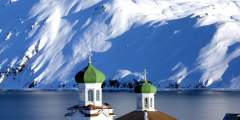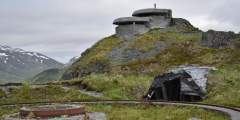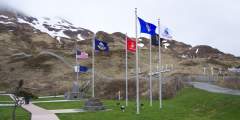Unalaska Historic Sites
The small island of Unalaska exudes history – both very old and more recent. The fascinating story of this place goes back more than 9,000 years, and you can see it illustrated in many spots around the island. Ancient Unangan artifacts housed at the Museum of the Aleutians give insight into the culture and history of the Native people. The Church of the Holy Ascension is a striking landmark offering proof of the influence Russians had on religious life here. And remnants of military buildings and bunkers give silent testimony to the strategic importance Unalaska had during World War II.
Most visitors to Unalaska can fit in a visit to both the Aleutian World War II Visitor’s Center and the Museum of the Aleutians in half a day (they are a little over a mile apart). If time affords, you can book a custom land tour with a local historian to see areas that interest you most. Or rent a car and follow the National Park Service driving guide, which highlights different World War II sites around the island. A stroll on Bayview Avenue between the Russian Orthodox Church/Bishop’s House and the Memorial Cemetery (about half a mile) also offers plenty to see.
As you enjoy the historic sites of Unalaska, keep in mind that it’s illegal to collect souvenirs. This includes World War II artifacts (shell casings, nails), archeological finds (stone tools) and natural items (ivory, eagle feathers, bones).
Show Map
Historic Park or Site
Captain James Cook saw much of Alaska’s coastline during his troubled third voyage in search of a Northwest Passage. Prince William Sound, Prince of Wales Island, Norton Sound, and Bristol Bay are just some of the places he named during his travels. English Bay, on the eastern side of Unalaska Island, references the two landings Cook and crew made there in 1778 (just months before his death in the Hawaiian Islands).
World War II buffs will want to check out remaining World War II defensive fortifications like elephant-steel magazines and the base-end station that overlook Summer Bay and Humpy Cove.
In the 1940’s more than 100 buildings peppered the hillside here, making up U.S. Army Base Fort Schwatka and Battery 402. This coastal outpost was considered cutting edge for its time. The Battery’s position high on Ulakta Head gave lookouts a strategic view and its 8‑inch, 21-ton guns boasted a range of 22 miles.
The striking Holy Ascension Russian Orthodox Church – with its red-shingled roofs and green onion domes – has become an integral part of the Unalaska skyline over the last century. It is both an oddity (architecturally different than anything else in the Aleutians) and a symbol of Russian influence on Aleut culture and religion.
If your travel group includes a WWII enthusiast, a wildlife devotee, a birder, and a kid who enjoys rolling around on the tundra, Bunker Hill is the perfect spot. Plus, it has the best photo ops, with a 360-degree view of the entire area: Captains Bay, Amaknak Island, Unalaska Bay and Iliuliuk Harbor.
The bow of the sunken SS Northwestern points to the sky in Captains Bay, a fifty-foot-high symbol of Alaska’s role in World War II. The Northwestern had a fascinating history even before Japanese warplanes bombed her on June 4, 1942. After transporting passengers, troops and bananas on the East Coast, she logged more than thirty years in northern waters, carrying passengers between Southeast Alaska and Seattle.
Memorial Park was built in 1992 in honor Coast Guard and Navy personnel that lost their lives during WWII.
When the United States military left Unalaska Island at the end of World War II, it also left behind buildings and equipment that would become war relics and reminders of the area’s importance during the Aleutian campaign, often called the “Forgotten War.” The buildings have deteriorated over the years and some have been torn down. But historical plaques marking the location of seven World War II points of interest were erected in 2007 to ensure ...more







